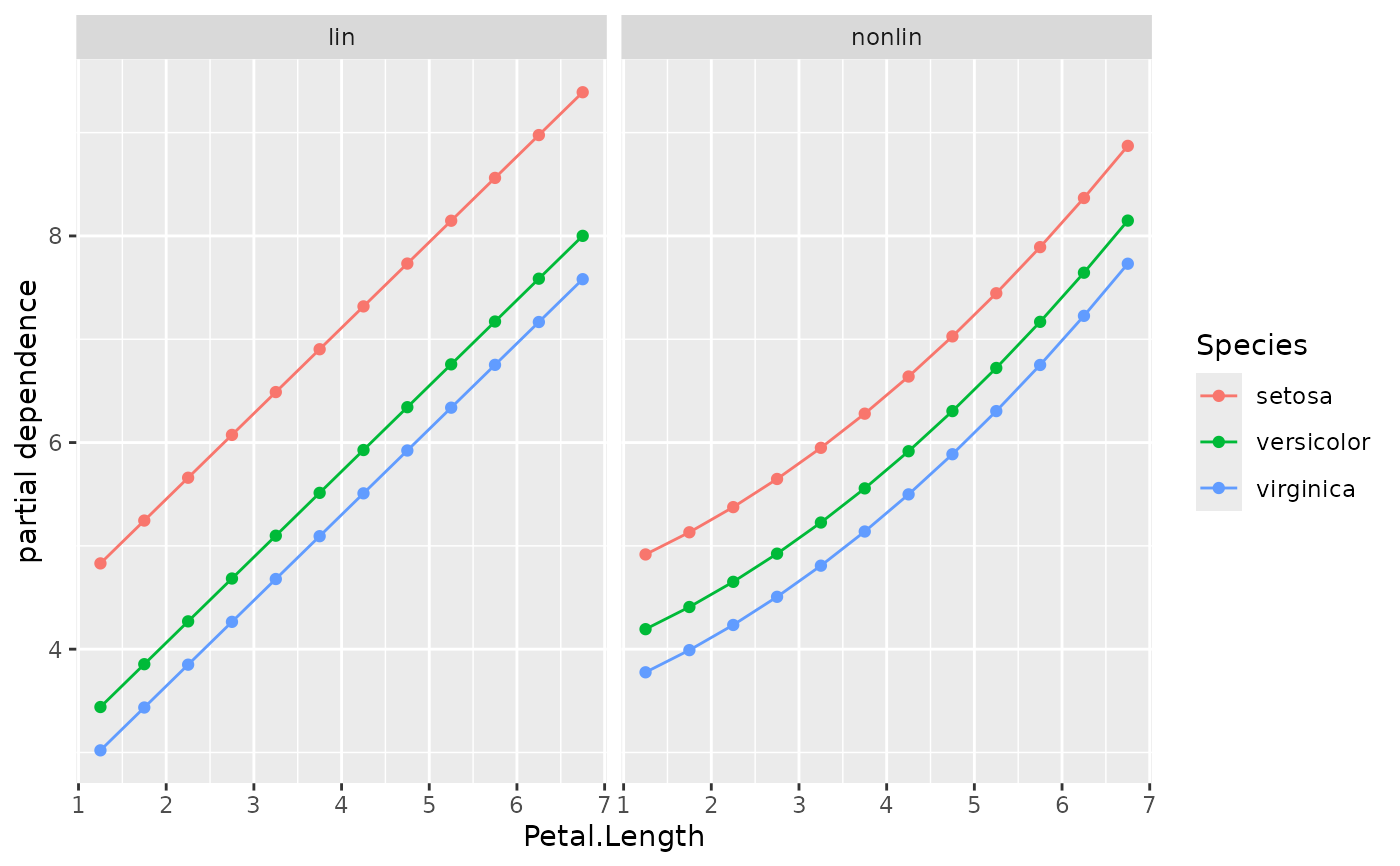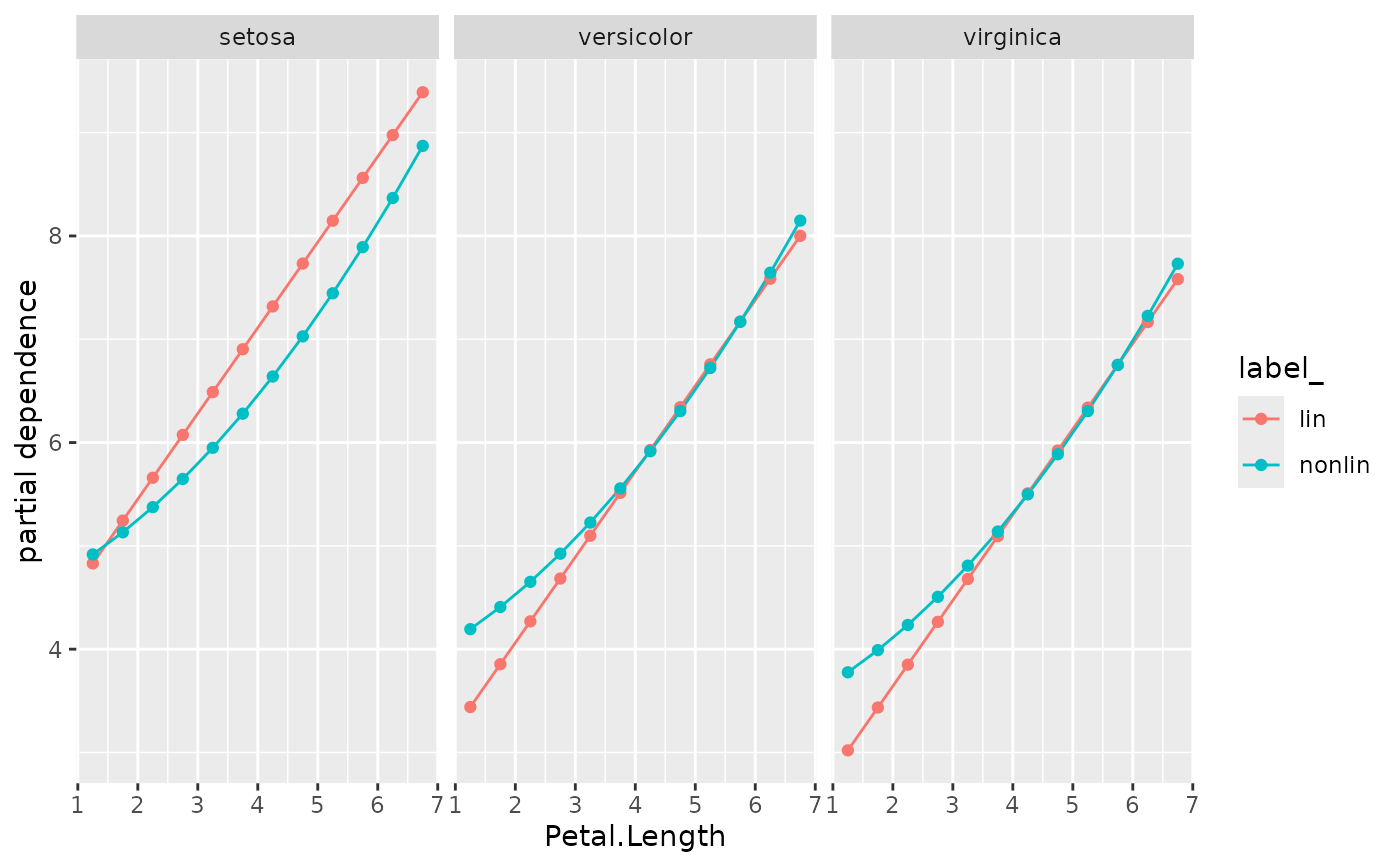Calculates different types of profiles across covariable values. By default, partial dependence profiles are calculated (see Friedman). Other options are profiles of ALE (accumulated local effects, see Apley), response, predicted values ("M plots" or "marginal plots", see Apley), and residuals. The results are aggregated either by (weighted) means or by (weighted) quartiles.
Note that ALE profiles are calibrated by (weighted) average predictions. In contrast to the suggestions in Apley, we calculate ALE profiles of factors in the same order as the factor levels. They are not being reordered based on similiarity of other variables.
light_profile(x, ...)
# Default S3 method
light_profile(x, ...)
# S3 method for class 'flashlight'
light_profile(
x,
v = NULL,
data = NULL,
by = x$by,
type = c("partial dependence", "ale", "predicted", "response", "residual", "shap"),
stats = "mean",
breaks = NULL,
n_bins = 11L,
cut_type = c("equal", "quantile"),
use_linkinv = TRUE,
counts = TRUE,
counts_weighted = FALSE,
v_labels = TRUE,
pred = NULL,
pd_evaluate_at = NULL,
pd_grid = NULL,
pd_indices = NULL,
pd_n_max = 1000L,
pd_seed = NULL,
pd_center = c("no", "first", "middle", "last", "mean", "0"),
ale_two_sided = FALSE,
...
)
# S3 method for class 'multiflashlight'
light_profile(
x,
v = NULL,
data = NULL,
type = c("partial dependence", "ale", "predicted", "response", "residual", "shap"),
breaks = NULL,
n_bins = 11L,
cut_type = c("equal", "quantile"),
pd_evaluate_at = NULL,
pd_grid = NULL,
...
)Arguments
- x
An object of class "flashlight" or "multiflashlight".
- ...
Further arguments passed to
formatC()in forming the cut breaks of thevvariable.- v
The variable name to be profiled.
- data
An optional
data.frame.- by
An optional vector of column names used to additionally group the results.
- type
Type of the profile: Either "partial dependence", "ale", "predicted", "response", or "residual".
- stats
Deprecated. Will be removed in version 1.1.0.
- breaks
Cut breaks for a numeric
v. Used to overwrite automatic binning vian_binsandcut_type. Ignored ifvis not numeric.- n_bins
Approximate number of unique values to evaluate for numeric
v. Ignored ifvis not numeric or ifbreaksis specified.- cut_type
Should a numeric
vbe cut into "equal" or "quantile" bins? Ignored ifvis not numeric or ifbreaksis specified.- use_linkinv
Should retransformation function be applied? Default is
TRUE.- counts
Should observation counts be added?
- counts_weighted
If
counts = TRUE: Should counts be weighted by the case weights? IfTRUE, the sum ofwis returned by group.- v_labels
If
FALSE, return group centers ofvinstead of labels. Only relevant for types "response", "predicted" or "residual" and ifvis being binned. In that case useful, for instance, if different flashlights use different data sets and bin labels would not match.- pred
Optional vector with predictions (after application of inverse link). Can be used to avoid recalculation of predictions over and over if the functions is to be repeatedly called for different
vand predictions are computationally expensive to make. Not implemented for multiflashlight.- pd_evaluate_at
Vector with values of
vused to evaluate the profile. Only relevant for type = "partial dependence" and "ale".- pd_grid
A
data.framewith grid values, e.g., generated byexpand.grid(). Only used for type = "partial dependence".- pd_indices
A vector of row numbers to consider in calculating partial dependence profiles and "ale".
- pd_n_max
Maximum number of ICE profiles to calculate (will be randomly picked from
data) for partial dependence and ALE.- pd_seed
Integer random seed used to select ICE profiles for partial dependence and ALE.
- pd_center
How should ICE curves be centered?
Default is "no".
Choose "first", "middle", or "last" to 0-center at specific evaluation points.
Choose "mean" to center all profiles at the within-group means.
Choose "0" to mean-center curves at 0. Only relevant for partial dependence.
- ale_two_sided
If
TRUE,vis continuous andbreaksare passed or being calculated, then two-sided derivatives are calculated for ALE instead of left derivatives. More specifically: Usually, local effects at value x are calculated using points in \([x-e, x]\). Setale_two_sided = TRUEto use points in \([x-e/2, x+e/2]\).
Value
An object of class "light_profile" with the following elements:
dataA tibble containing results.byNames of group by variable.vThe variable(s) evaluated.typeSame as inputtype. For information only.
Details
Numeric covariables v with more than n_bins disjoint values
are binned into n_bins bins. Alternatively, breaks can be provided
to specify the binning. For partial dependence profiles
(and partly also ALE profiles), this behaviour can be overwritten either
by providing a vector of evaluation points (pd_evaluate_at) or an
evaluation pd_grid. By the latter we mean a data frame with column name(s)
with a (multi-)variate evaluation grid.
For partial dependence, ALE, and prediction profiles, "model", "predict_function", "linkinv" and "data" are required. For response profiles its "y", "linkinv" and "data". "data" can also be passed on the fly.
Methods (by class)
light_profile(default): Default method not implemented yet.light_profile(flashlight): Profiles for flashlight.light_profile(multiflashlight): Profiles for multiflashlight.
References
Friedman J. H. (2001). Greedy function approximation: A gradient boosting machine. The Annals of Statistics, 29:1189–1232.
Apley D. W. (2016). Visualizing the effects of predictor variables in black box supervised learning models.
See also
Examples
fit_lin <- lm(Sepal.Length ~ ., data = iris)
fl_lin <- flashlight(model = fit_lin, label = "lin", data = iris, y = "Sepal.Length")
# PDP by Species
plot(light_profile(fl_lin, v = "Petal.Length", by = "Species"))
 # Average predicted
plot(light_profile(fl_lin, v = "Petal.Length", type = "pred"))
# Average predicted
plot(light_profile(fl_lin, v = "Petal.Length", type = "pred"))
 # Second model with non-linear Petal.Length effect
fit_nonlin <- lm(Sepal.Length ~ . + I(Petal.Length^2), data = iris)
fl_nonlin <- flashlight(
model = fit_nonlin, label = "nonlin", data = iris, y = "Sepal.Length"
)
fls <- multiflashlight(list(fl_lin, fl_nonlin))
# PDP by Species
plot(light_profile(fls, v = "Petal.Length", by = "Species"))
# Second model with non-linear Petal.Length effect
fit_nonlin <- lm(Sepal.Length ~ . + I(Petal.Length^2), data = iris)
fl_nonlin <- flashlight(
model = fit_nonlin, label = "nonlin", data = iris, y = "Sepal.Length"
)
fls <- multiflashlight(list(fl_lin, fl_nonlin))
# PDP by Species
plot(light_profile(fls, v = "Petal.Length", by = "Species"))
 plot(light_profile(fls, v = "Petal.Length", by = "Species"), swap_dim = TRUE)
plot(light_profile(fls, v = "Petal.Length", by = "Species"), swap_dim = TRUE)
 # Average residuals (calibration)
plot(light_profile(fls, v = "Petal.Length", type = "residual"))
# Average residuals (calibration)
plot(light_profile(fls, v = "Petal.Length", type = "residual"))
